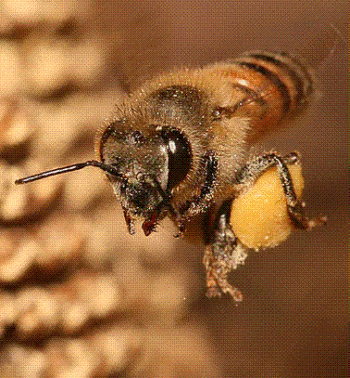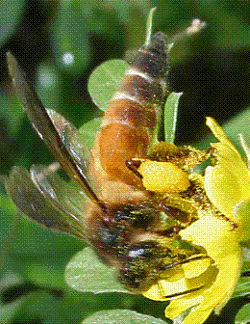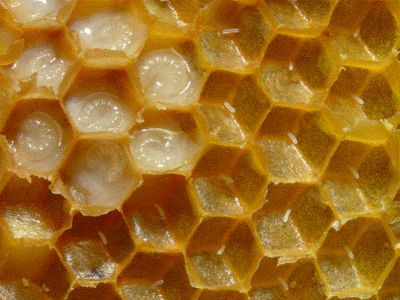 SKC Films Library |
| SKC Films Library >> Insects >> Order Hymenoptera |
| Honeybee Apis spp, "friend of agriculture"
Description Honeybees are about 3/4 inches long, except for queens, which can be over an inch in length. There are four species of honeybee, but all are reddish brown and black with orangish-yellow rings on abdomen, with black head, antennae and legs. Honeybees are the only type of bee to have a poisonous stinger, which is actually a modified ovipositor (egg-laying structure); only female honeybees have stingers, however, and, since the stinger and poison sac "replace" the ovary and ovipositor, all female honeybees except the queen are sterile. Unlike other stinging insects, a honeybee can only use its stinger once; barbs keep the stinger firmly embedded in the victim, so when the bee withdraws it must literally leave its insides behind with the stinger and the bee will die soon after, having given its life to defend its hive.
Habitat and Distribution The four species of honeybee are found in a wide range of habitats across much of the globe, except for arctic regions and areas without an abundance of flowering plants. The western (European) honeybee, native to Europe and the Mediterranean region, was first domesticated by the ancient Egyptians and is now kept by beekeepers around the world. Wild honeybees typically build their hives inside a hollow tree, but will also readily take advantage of brood boxes and other man-made structures, as long as they are within reasonable flying distance of reliable food sources. Social Structure All honeybees within a hive belong to one of three social classes -- queen, worker, and drone. The queen is the only female in the hive that can lay eggs, and a single queen can lay over 1,500 eggs per day. There can only ever be one queen in a hive at a time, so if a larva develops into a queen while the current "monarch" is still alive the new queen will fly off with some of the workers and drones to start a new hive elsewhere. If the current queen dies, the workers will feed one of the queen larvae a special diet known as "royal jelly" to speed up its growth. The workers will also hasten the development of a new queen if the hive is becoming too crowded and needs to be "split up." How the workers know which larvae are "programmed" to become queens is not known. The vast majority of bees in a honeybee hive are workers, all of whom are female. A worker bee begins her "career" doing comb construction, brood rearing, hive cleaning, etc., and "works up" to become a collector of pollen and nectar. All worker bees have a special structure known as a corbiculum on each hind leg to carry pollen (as seen in the picture above), an extra stomach for storing and transporting nectar, and four special glands on the underside of the abdomen to secrete beeswax. There are seldom more than a couple hundred male (drone) bees in a hive, and their only function is to mate with the queen. Drones are cared for by workers while doing their job, but are driven out in late fall as the hive prepares to go into "winter mode," when it will have to rely on food stores to survive. Diet Honeybees will take nectar and pollen from any flowering plants available, but individual hives often develop a preference for a specific patch of flowers or trees and will return to that patch every day until that supply has been exhausted, at which time it will send out a "search party" to locate a new patch. As it feeds, the honeybee will get some of the pollen on its face and legs, and when the bee moves on to another flower some of that pollen will stay behind and fertilize that flower, while some of that flower's pollen in turn gets transported to another flower, and so on. Many fruit trees and other flowering plants have become so dependent on the honeybee to transport their pollen that they have become incapable of dispersing pollen any other way, which is why bee hives are an important piece of "equipment" at most commercial orchards.
Although a bee will consume some of the nectar and pollen it collects, it will take most of it back to the hive. Some of the nectar and pollen is stored as is, but most will be converted into honey, which is fed to the larvae. Honeybees remain active through the winter, surviving on the stored nectar and pollen and by consuming and metabolizing excess honey.
Other Information The honeybee's importance to agriculture has led to it being designated the state insect of Arkansas, Georgia, Kansas, Louisiana, Maine, Mississippi, Missouri, Nebraska, New Jersey, North Carolina, Oklahoma, South Dakota, Tennessee, Utah, Vermont, and Wisconsin. Cave drawings show that man has been collecting honey for at least 8,000 years, while the ancient Egyptians were the earliest known beekeepers. "Killer bees" are a strain of western honeybees that were originally bred to be better adapted to the tropics. Although they did indeed prove well suited to that environment, they also proved to be much more aggressive than other honeybees and it was hoped that further crossbreeding would tame the aggressiveness while keeping the increased honey production. Unfortunately, a colony of Africanized honeybees was accidentally released in South America in 1957 before the aggressiveness could be bred out. Because Africanized honeybees had also been bred to develop from larvae to adults sooner than other strains, the one colony quickly became hundreds of colonies, and within a span of just a few years colonies of Africanized honeybees were being found in Texas and other parts of the southern United States. Although wild colonies of "killer bees" continue to threaten many areas of South and Central America and the southern United States, their spread northward has effectively been checked by colder temperatures as they move north, and some of their aggressiveness has been naturally bred out as some colonies have interbred with less aggressive native bees. Scientific Classification phlyum Arthropoda
|
| SKC Films Library >> Insects >> Order Hymenoptera This page was last updated on June 19, 2018. |



